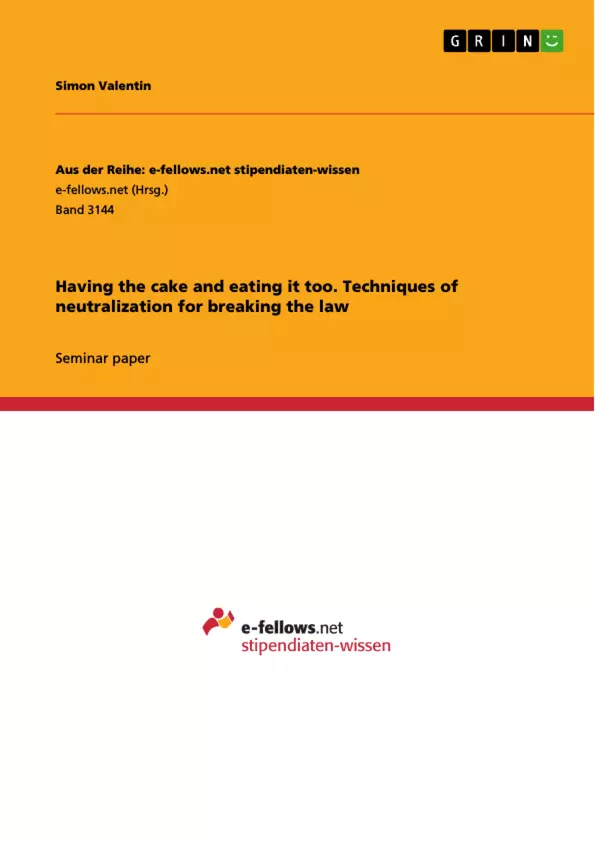Discovering facilitating factors and mechanisms that drive people to law-breaking behavior is one of the most important and interesting questions of civilization. Techniques of neutralization is an interesting psychological phenomenon that might facilitate delinquent behavior. In this essay, I will describe the main idea, explain the different forms, and finally put the findings in a broader context.
Inhaltsverzeichnis (Table of Contents)
- Introduction
- Techniques of Neutralization
- The Denial of Responsibility – “I didn't mean it”
- The Denial of Injury – “I didn't really hurt anybody”
- The Denial of the Victim – “They had it coming to them”
- The Condemnation of the Condemners – “Everybody's picking on me”
- The Appeal to Higher Loyalties – “I didn't do it for myself”
- Conclusion and outlook
Zielsetzung und Themenschwerpunkte (Objectives and Key Themes)
This essay aims to explain the theory of techniques of neutralization as developed by Sykes and Matza, highlighting its significance in understanding delinquent behavior. The theory challenges traditional explanations of deviance by suggesting that delinquents utilize rationalizations to justify their actions, thereby neutralizing the moral implications of their behavior.
- Techniques of neutralization as a psychological phenomenon facilitating delinquent behavior
- The critique of deviant sub-culture theory and the shift towards explaining delinquency within the dominant social order
- The five main forms of techniques of neutralization and their applications in justifying deviant behavior
- The impact of techniques of neutralization on social control and their prevalence beyond juvenile delinquency
- The potential for preventive measures to counter neutralization techniques and promote responsibility
Zusammenfassung der Kapitel (Chapter Summaries)
The introduction sets the stage by introducing the concept of techniques of neutralization as a theory for explaining delinquent behavior. It highlights the groundbreaking work of Sykes and Matza in this area and provides a historical context for their theory by contrasting it with existing perspectives on deviance.
The chapter "Techniques of Neutralization" delves into the core of the theory, outlining how delinquents utilize rationalizations to justify their actions. The authors argue that these techniques serve to neutralize the moral implications of their behavior, allowing them to maintain their self-image and avoid guilt.
The chapter further examines the five main forms of techniques of neutralization: denial of responsibility, denial of injury, denial of the victim, condemnation of the condemners, and appeal to higher loyalties. Each technique is explained in detail, illustrating how they are employed by delinquents to rationalize their actions.
Schlüsselwörter (Keywords)
The essay focuses on the concept of techniques of neutralization, exploring its role in explaining delinquent behavior and its impact on social control. Key terms include: techniques of neutralization, delinquent behavior, deviant behavior, social control, rationalization, justification, denial of responsibility, denial of injury, denial of the victim, condemnation of the condemners, appeal to higher loyalties, and social order.
- Arbeit zitieren
- Simon Valentin (Autor:in), 2018, Having the cake and eating it too. Techniques of neutralization for breaking the law, München, GRIN Verlag, https://www.grin.com/document/491915



